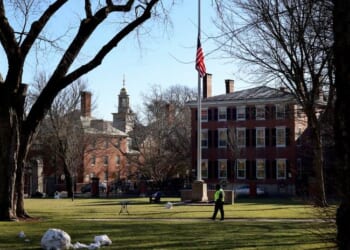Trump’s state visit to Britain marked huge commitments from US tech giants and SMR developers to build here.
X-Energy struck a deal to build 12 advanced modular nuclear reactors in Hartlepool. EDF and Tritax are working with Holtec on plans to turn the site of the old Cottam coal-fired power plant into a new nuclear-data centre hub. And London Gateway port is set to be electrified with new micro-reactors from Last Energy.
We are a long-way from spades in the ground, but these deals are proof of the massive potential of nuclear to re-power British industry with low-carbon energy.
What makes Britain so attractive to the US nuclear developers? In short, the highest industrial power costs in the developed world. Even before Russia’s invasion of Ukraine, British industry paid almost twice more for electricity than their US counterparts. There’s a big opportunity to undercut our expensive grid and sell directly to industry.
There’s just one hurdle: regulation. Britain is the most expensive place in the world to build a new nuclear power station. Hinkley Point C is set to be the most expensive nuclear power plant built anywhere, ever.
Why is Hinkley Point C so expensive to build? Too many reasons to list, but a big one is the staggering number of design changes required by UK regulators. On top of a world-first ‘fish returns system’ and the infamous ‘fish disco’ – speakers playing jumbo jet level noise to protect fish – Hinkley contains numerous extra safety features that its French and Finnish counterparts don’t.
They include a separate hard-wired control and instrumentation system and extra diesel backup generation. France and Finland built plants using the same basic ‘EPR’ design for around half the cost.
At least Hinkley Point C will be built. Plans to build a new reactor on the island of Anglesey in North Wales failed due to planning and financing issues. One reason GE-Hitachi’s plan was hard to finance was the Office for Nuclear Regulation’s (ONR) insistence on expensive and ineffective UK-specific safety measures.
Take the requirement to add bulky filters to every heating, ventilation and air‑conditioning (HVAC) duct. The filters cut public exposure by 0.0001 Millisieverts – 27,000 times less than what the average Brit receives each year from natural sources. Or put differently, the same amount you receive from eating a banana.
And when Westinghouse went through the UK’s regulatory process, they were asked to completely redesign the way they managed their spent-fuel from one that had been used extensively in the US – cutting the amount they could store at any one time by a third.
It is worth remembering that the plants in question are themselves much, much, safer than older plants. The ABWR design that GE-Hitachi wanted to build (and the ONR required extra bulky filters for) survived an earthquake 32,000 times more powerful than the biggest recorded quake in British history.
Of course, those old plants built in the 60s and 70s racked up tens of thousands of years of safe operation cumulatively. Analysis by Our World In Data found that nuclear has the fewest deaths per megawatt generated of any source of power.
The US is testing dozens of micro-reactor designs – more than the rest of the world combined. If we want firms like X-Energy, Last Energy, and Holtec to build them in Britain then it is vital we don’t repeat the mistakes above.
The good news is there is a new understanding between the UK and US on nuclear regulation. Moving forward, Britain’s Office for Nuclear Regulation and the US’s Nuclear Regulatory Commission will recognise each other’s safety analyses. This is expected to slash reactor approval times in half.
It is a positive step and will have been a decisive factor in the deals announced already. However, we can and should go further. There is precedent.
One of the many complications of Britain’s exit from the European Union was what to do about medicines. Winning regulatory approval is a very complicated and expensive business, and Britain is a small market – at least compared to the US or EU. There was a serious possibility that we would end up, in the words of Barack Obama, at the back of the queue for new drugs.
To make sure Brits didn’t miss out on new life-saving cures and treatments, the last Government made a big call. Instead of waiting for drug companies to submit data and go through Britain’s approval process, we agreed to trust the judgments of respected regulators like the US’s FDA and European Medicines Agency. Drugs approved abroad would be available in Britain even if our regulator hadn’t directly approved them.
Britain Remade’s new Policy Playbook for Cheaper Nuclear argues we should do the same for nuclear. Safety analyses from all trusted peer regulators should be accepted by default – even if they don’t return the favour – and UK-specific design changes should only be requested where there is a clear, evidence‑based need.
Nuclear can rebuild British industry with clean power. There’s no shortage of businesses who want to build new small modular reactors in Britain, nor of tech giants who want to buy the electricity they produce. The only question is whether or not we will let them.


![Scott Bessent Explains The Big Picture Everyone is Missing During the Shutdown [WATCH]](https://www.right2024.com/wp-content/uploads/2025/11/Scott-Bessent-Explains-The-Big-Picture-Everyone-is-Missing-During-350x250.jpg)




![Florida Files Supreme Court Case After Illegal Immigrant Truck Driver Kills Three [WATCH]](https://www.right2024.com/wp-content/uploads/2025/10/Florida-Files-Supreme-Court-Case-After-Illegal-Immigrant-Truck-Driver-350x250.jpg)







